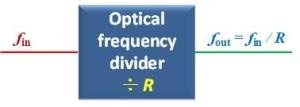Oct 24 2016
Frequency synthesizers from audio frequency to the microwave region have been widely used in daily life, high technology and scientific research. Those frequency synthesizers can output a signal with frequency related to the input light frequency (fin) as fin/R. Meanwhile, the phase coherence, frequency stability and accuracy of the output signal inherit from the input signal. While in the optical region, there was no such a device. Since the invention of lasers, scientists are able to realize optical frequency conversion with nonlinear optical process. For example, second harmonic generation can convert optical frequencies as fout = fin/0.5, where fout is the output light frequency. However, optical frequency conversion with arbitrary ratios has not been realized for a long time.
 Diagram of an optical frequency divider. (CREDIT: ©Science China Press)
Diagram of an optical frequency divider. (CREDIT: ©Science China Press)
The invention of optical frequency comb paved the way for optical frequency divider. In 2003, international comparison among four optical frequency combs from East China Normal University (ECNU, China), National Institute of Standards and Technology (NIST, USA) and International Bureau of Weights and Measures (BIPM) was performed, which demonstrated that the frequency synthesis uncertainty of optical frequency combs based on different types of femtosecond lasers was at the 10^(-19) level (Long-Sheng Ma, et. al, Science, Vol. 303, page.1843, 2004). Recently, the group from ECNU has realized a low noise, accurate optical frequency divider by combining several key techniques of an optically-referenced frequency comb, a collinear self-referencing interferometer for detecting the comb carrier-envelope offset frequency, an optically-referenced RF time base, and the transfer oscillator scheme. By comparing against the frequency ratio between the fundamental and second harmonic of a 1064 nm laser instead of a second copy of the identical optical frequency divider, the division uncertainty is demonstrated to be 1.4 × 10^(-21). The optical frequency divider can accurately divide an optical frequency with an arbitrary preset ratio to several different wavelengths. Scientists are able to measure optical frequency ratios directly from the division ratios of the optical frequency dividers when the output and input light of the optical frequency dividers correspond to clock frequencies.
Optical frequency divider will be instrumental in the applications of optical clocks. "Recent progress in optical atomic clocks demonstrates record fractional frequency instability and uncertainty at the 10^(-18) level. The unprecedented accuracy is fostering a revolution in science and technology. Using optical clocks, searches for possible variations of fundamental constants are carried out in laboratories by precisely measuring the frequency ratios of two different atomic transitions of optical clocks over time. In relativistic geodesy, long-distance geopotential difference will be accurately measured by comparing the frequencies of remotely-located optical clocks linked with optical fibers, where the frequencies of optical clocks have to be accurately converted to the fiber telecom band for long-distance transmission. In metrology, the fundamental unit for time, the second, in the International System of Units (SI) will be redefined based on optical atomic clocks. Frequency comparisons between optical clocks based on different atom species have to be performed in order to affirm the agreement between optical clocks with uncertainty beyond the current SI second, as well as to demonstrate the frequency reproducibility of optical clocks. Moreover, in atomic and molecular precision spectroscopy hopes are high that accurate and stable clock light can be transferred to wider spectral range. All those applications rely on accurate frequency ratio measurement between spectrally-separated optical clocks or frequency conversion of optical clocks."
In a research article published in the Beijing-based National Science Review, Yao et. al. introduce an optical frequency divider with division uncertainty at the 10^(-21) level. The division uncertainty induced by the optical frequency divider is therefore three orders of magnitude better than the most accurate optical clocks, promising optical frequency division without degrading the performance of optical clocks. They hope this type of optical frequency divider will be also instrumental in precision measurement.